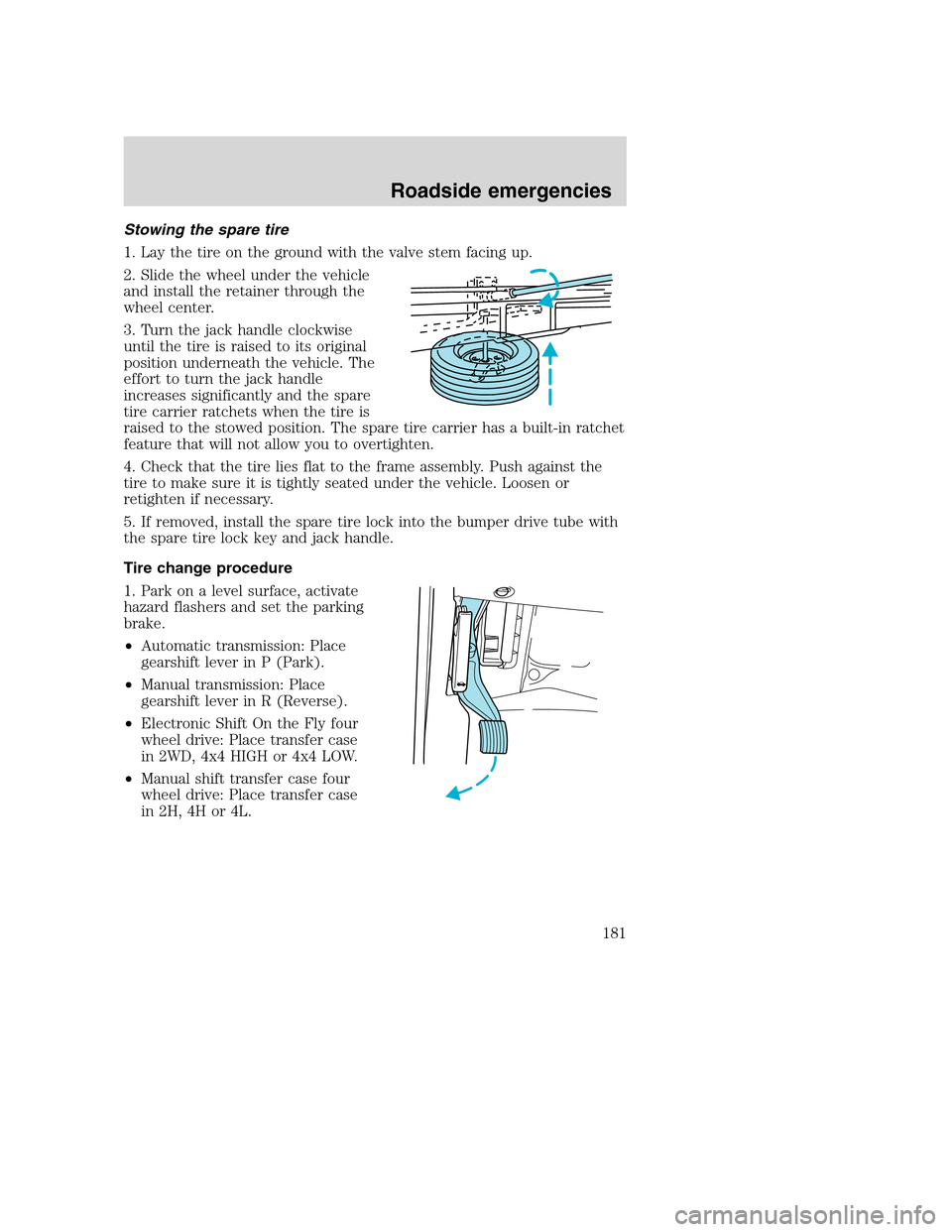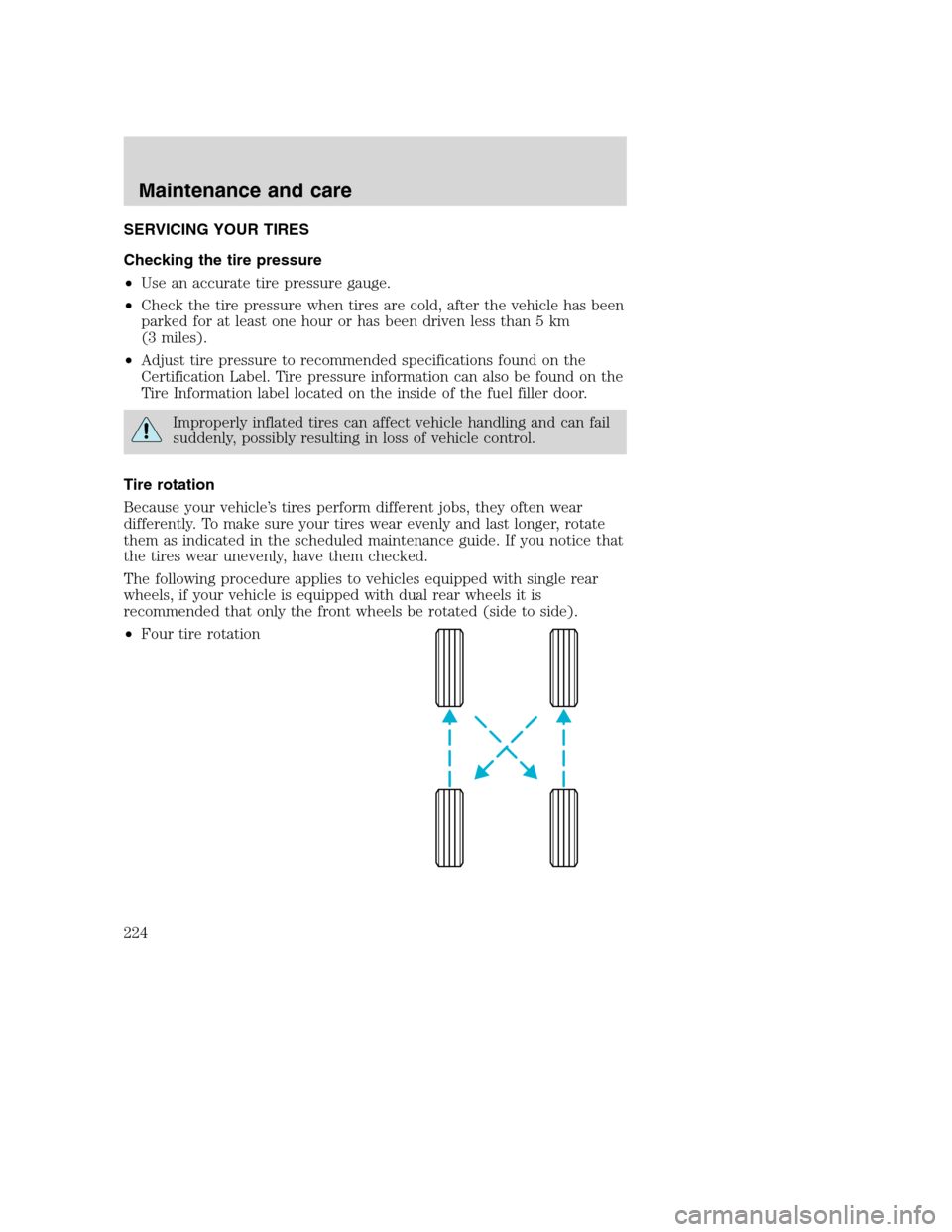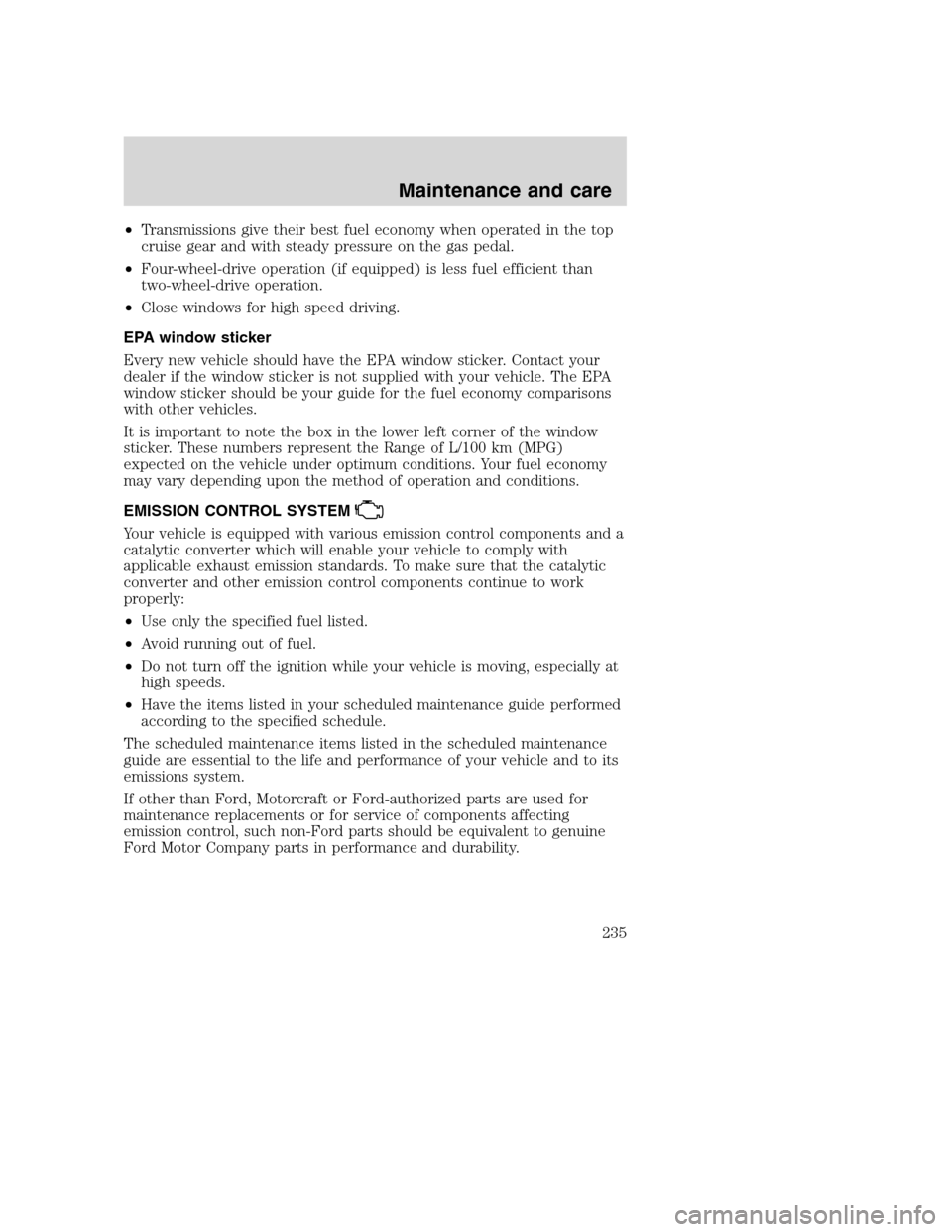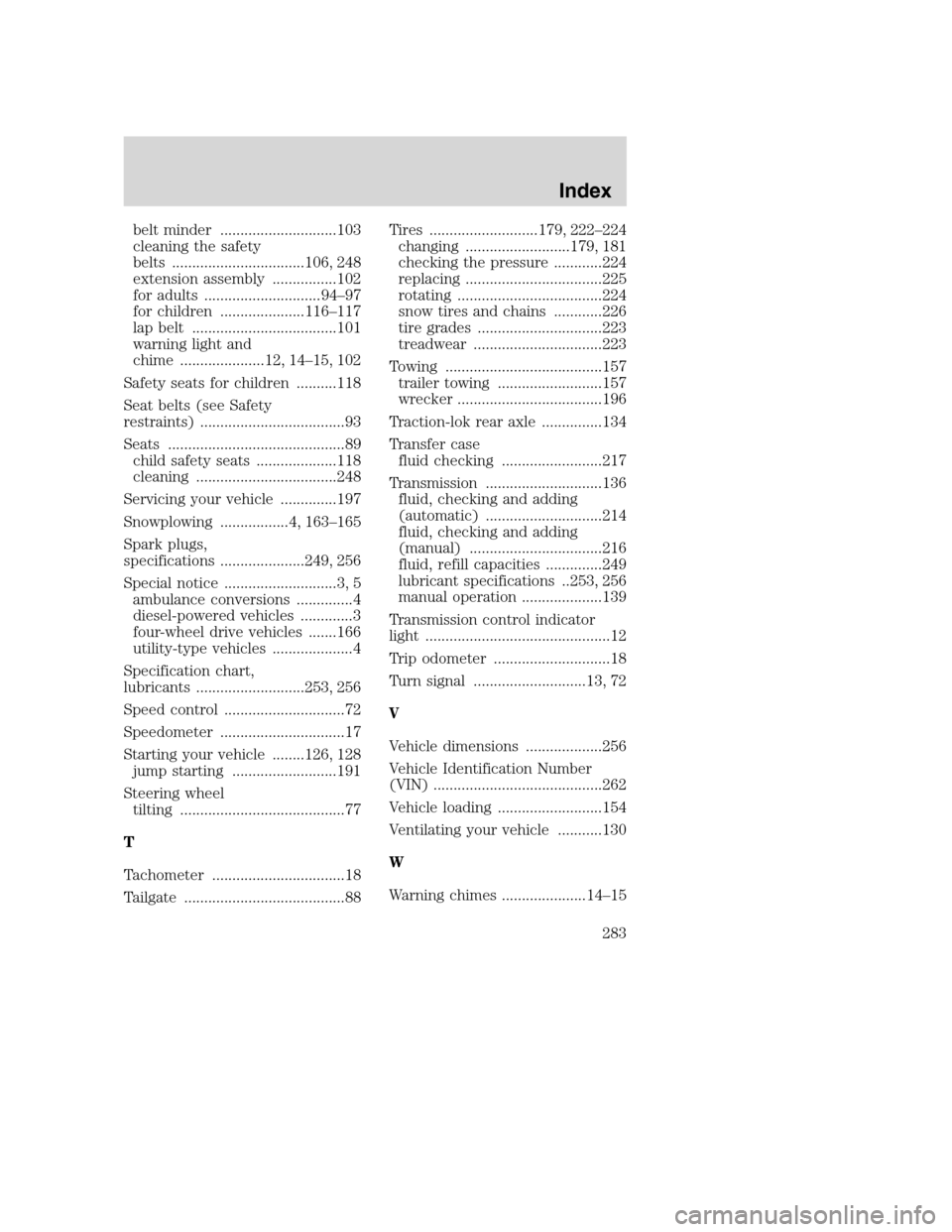2001 FORD SUPER DUTY four wheel drive
[x] Cancel search: four wheel drivePage 181 of 288

Stowing the spare tire
1. Lay the tire on the ground with the valve stem facing up.
2. Slide the wheel under the vehicle
and install the retainer through the
wheel center.
3. Turn the jack handle clockwise
until the tire is raised to its original
position underneath the vehicle. The
effort to turn the jack handle
increases significantly and the spare
tire carrier ratchets when the tire is
raised to the stowed position. The spare tire carrier has a built-in ratchet
feature that will not allow you to overtighten.
4. Check that the tire lies flat to the frame assembly. Push against the
tire to make sure it is tightly seated under the vehicle. Loosen or
retighten if necessary.
5. If removed, install the spare tire lock into the bumper drive tube with
the spare tire lock key and jack handle.
Tire change procedure
1. Park on a level surface, activate
hazard flashers and set the parking
brake.
•Automatic transmission: Place
gearshift lever in P (Park).
•Manual transmission: Place
gearshift lever in R (Reverse).
•Electronic Shift On the Fly four
wheel drive: Place transfer case
in 2WD, 4x4 HIGH or 4x4 LOW.
•Manual shift transfer case four
wheel drive: Place transfer case
in 2H, 4H or 4L.
Roadside emergencies
181
Page 224 of 288

SERVICING YOUR TIRES
Checking the tire pressure
•Use an accurate tire pressure gauge.
•Check the tire pressure when tires are cold, after the vehicle has been
parked for at least one hour or has been driven less than 5 km
(3 miles).
•Adjust tire pressure to recommended specifications found on the
Certification Label. Tire pressure information can also be found on the
Tire Information label located on the inside of the fuel filler door.
Improperly inflated tires can affect vehicle handling and can fail
suddenly, possibly resulting in loss of vehicle control.
Tire rotation
Because your vehicle’s tires perform different jobs, they often wear
differently. To make sure your tires wear evenly and last longer, rotate
them as indicated in the scheduled maintenance guide. If you notice that
the tires wear unevenly, have them checked.
The following procedure applies to vehicles equipped with single rear
wheels, if your vehicle is equipped with dual rear wheels it is
recommended that only the front wheels be rotated (side to side).
•Four tire rotation
Maintenance and care
224
Page 235 of 288

•Transmissions give their best fuel economy when operated in the top
cruise gear and with steady pressure on the gas pedal.
•Four-wheel-drive operation (if equipped) is less fuel efficient than
two-wheel-drive operation.
•Close windows for high speed driving.
EPA window sticker
Every new vehicle should have the EPA window sticker. Contact your
dealer if the window sticker is not supplied with your vehicle. The EPA
window sticker should be your guide for the fuel economy comparisons
with other vehicles.
It is important to note the box in the lower left corner of the window
sticker. These numbers represent the Range of L/100 km (MPG)
expected on the vehicle under optimum conditions. Your fuel economy
may vary depending upon the method of operation and conditions.
EMISSION CONTROL SYSTEM
Your vehicle is equipped with various emission control components and a
catalytic converter which will enable your vehicle to comply with
applicable exhaust emission standards. To make sure that the catalytic
converter and other emission control components continue to work
properly:
•Use only the specified fuel listed.
•Avoid running out of fuel.
•Do not turn off the ignition while your vehicle is moving, especially at
high speeds.
•Have the items listed in your scheduled maintenance guide performed
according to the specified schedule.
The scheduled maintenance items listed in the scheduled maintenance
guide are essential to the life and performance of your vehicle and to its
emissions system.
If other than Ford, Motorcraft or Ford-authorized parts are used for
maintenance replacements or for service of components affecting
emission control, such non-Ford parts should be equivalent to genuine
Ford Motor Company parts in performance and durability.
Maintenance and care
235
Page 280 of 288

fail-safe coolant ......................211
idle speed control ...................219
lubrication
specifications ..................253, 256
refill capacities ........................249
service points ..........................200
starting after a collision .........168
Engine block heater .................129
Engine oil ..................................201
checking and adding ..............201
dipstick ....................................201
filter, specifications ........203, 249
recommendations ...................203
refill capacities ........................249
specifications ..................253, 256
Exhaust fumes ..........................129
F
Fail safe cooling ........................211
Fluid capacities .........................249
Foglamps .....................................26
Four-Wheel Drive
vehicles ................................13, 145
control trac ...............................27
description ..............................149
driving off road .......................151
electronic shift ..........27, 145, 149
indicator light ...................14, 146
lever operated shift ................147
manual locking hubs ..............146
preparing to drive your
vehicle .....................................135
Fuel ............................................227
calculating fuel economy .......232
cap ...........................................231
capacity ...................................249
choosing the right fuel ...........229comparisons with EPA fuel
economy estimates .................235
detergent in fuel .....................230
filling your vehicle
with fuel ..................227, 231–232
filter, specifications ........231, 249
fuel pump shut-off switch .....168
gauge .........................................16
improving fuel economy ........232
low fuel warning light ..............10
octane rating ...................229, 256
quality ......................................230
running out of fuel .................230
safety information relating to
automotive fuels .....................227
Fuses ..................................170–171
G
Gas cap (see Fuel cap) ............231
Gas mileage (see Fuel
economy) ...................................232
Gauges .........................................16
battery voltage gauge ...............19
engine coolant temperature
gauge .........................................17
engine oil pressure gauge ........19
fuel gauge ..................................16
odometer ...................................18
speedometer .............................17
tachometer ................................18
trip odometer ............................18
GAWR (Gross Axle Weight
Rating) .......................................154
calculating ...............................156
definition .................................154
driving with a heavy load ......154
location ....................................154
GVWR (Gross Vehicle Weight
Rating) .......................................154
Index
280
Page 283 of 288

belt minder .............................103
cleaning the safety
belts .................................106, 248
extension assembly ................102
for adults .............................94–97
for children .....................116–117
lap belt ....................................101
warning light and
chime .....................12, 14–15, 102
Safety seats for children ..........118
Seat belts (see Safety
restraints) ....................................93
Seats ............................................89
child safety seats ....................118
cleaning ...................................248
Servicing your vehicle ..............197
Snowplowing .................4, 163–165
Spark plugs,
specifications .....................249, 256
Special notice ............................3, 5
ambulance conversions ..............4
diesel-powered vehicles .............3
four-wheel drive vehicles .......166
utility-type vehicles ....................4
Specification chart,
lubricants ...........................253, 256
Speed control ..............................72
Speedometer ...............................17
Starting your vehicle ........126, 128
jump starting ..........................191
Steering wheel
tilting .........................................77
T
Tachometer .................................18
Tailgate ........................................88Tires ...........................179, 222–224
changing ..........................179, 181
checking the pressure ............224
replacing ..................................225
rotating ....................................224
snow tires and chains ............226
tire grades ...............................223
treadwear ................................223
Towing .......................................157
trailer towing ..........................157
wrecker ....................................196
Traction-lok rear axle ...............134
Transfer case
fluid checking .........................217
Transmission .............................136
fluid, checking and adding
(automatic) .............................214
fluid, checking and adding
(manual) .................................216
fluid, refill capacities ..............249
lubricant specifications ..253, 256
manual operation ....................139
Transmission control indicator
light ..............................................12
Trip odometer .............................18
Turn signal ............................13, 72
V
Vehicle dimensions ...................256
Vehicle Identification Number
(VIN) ..........................................262
Vehicle loading ..........................154
Ventilating your vehicle ...........130
W
Warning chimes .....................14–15
Index
283